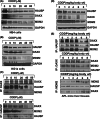p53 as a unique target of action of cisplatin in acute leukaemia cells
- PMID: 35946055
- PMCID: PMC9443951
- DOI: 10.1111/jcmm.17502
p53 as a unique target of action of cisplatin in acute leukaemia cells
Abstract
Acute promyelocytic leukaemia (APL) occurs in approximately 10% of acute myeloid leukaemia patients. Arsenic trioxide (ATO) has been for APL chemotherapy, but recently several ATO-resistant cases have been reported worldwide. Cisplatin (CDDP) enhances the toxicity of ATO in ovarian, lung cancer, chronic myelogenous leukaemia, and HL-60 cells. Hence, the goal of this study was to investigate a novel target of CDDP action in APL cells, as an alternate option for the treatment of ATO-resistant APL patients. We applied biochemical, molecular, confocal microscopy and advanced gene editing (CRISPR-Cas9) techniques to elucidate the novel target of CDDP action and its functional mechanism in APL cells. Our main findings revealed that CDDP activated p53 in APL cells through stress signals catalysed by ATM and ATR protein kinases, CHK1 and CHK2 phosphorylation at Ser 345 and Thr68 residues, and downregulation and dissociation of MDM2-DAXX-HAUSP complex. Our functional studies confirmed that CDDP-induced repression of MDM2-DAXX-HAUSP complex was significantly reversed in both nutilin-3-treated KG1a and p53-knockdown NB4 cells. Our findings also showed that CDDP stimulated an increased number of promyelocytes with dense granules, activated p53 expression, and downregulated MDM2 in liver and bone marrow of APL mice. Principal conclusion of our study highlights a novel mode of action of CDDP targeting p53 expression which may provide a basis for designing new anti-leukaemic compounds for treatment of APL patients.
Keywords: CRISPR-Cas9; MDM2-DAXX-HAUSP; acute promyelocytic leukaemia; cisplatin; p53.
© 2022 The Authors. Journal of Cellular and Molecular Medicine published by Foundation for Cellular and Molecular Medicine and John Wiley & Sons Ltd.
Conflict of interest statement
The authors declare that they have no competing interests.
Figures







References
-
- Powell BL. Arsenic trioxide in acute promyelocytic leukemia: potion not poison. Expert Rev Anticancer Ther. 2011;11:1317‐1319. - PubMed
-
- Grignani F, Fagioli M, Alcalay M. Acute promyelocytic leukemia: from genetics to treatment. Blood. 1994;83:10‐25. - PubMed
-
- Lo‐Coco F, Avvisati G, Vignetti M, et al. Retinoic acid and arsenic trioxide for acute promyelocytic leukemia. N Engl J Med. 2013;369:111‐121. - PubMed
Publication types
MeSH terms
Substances
Grants and funding
LinkOut - more resources
Full Text Sources
Medical
Research Materials
Miscellaneous

